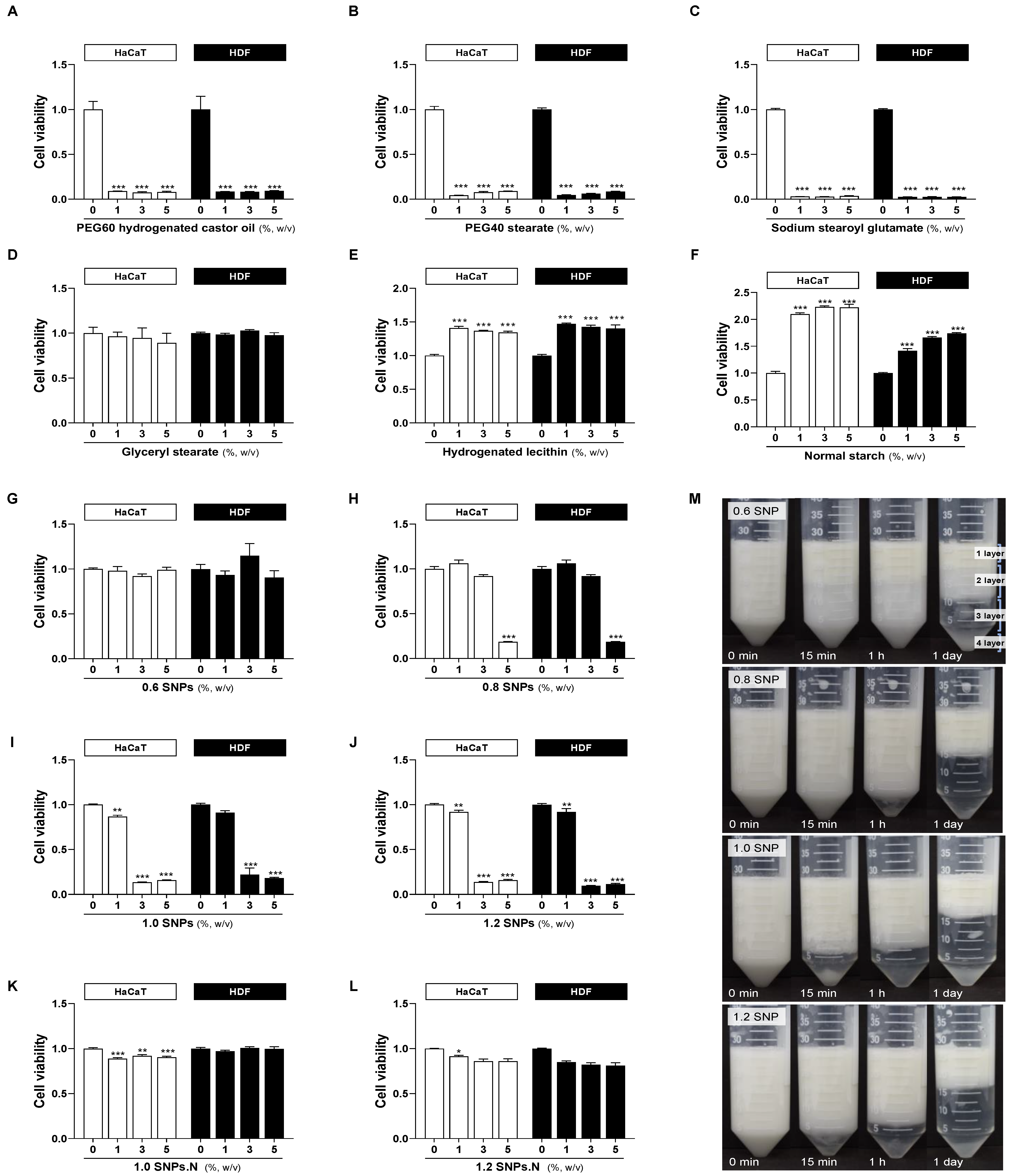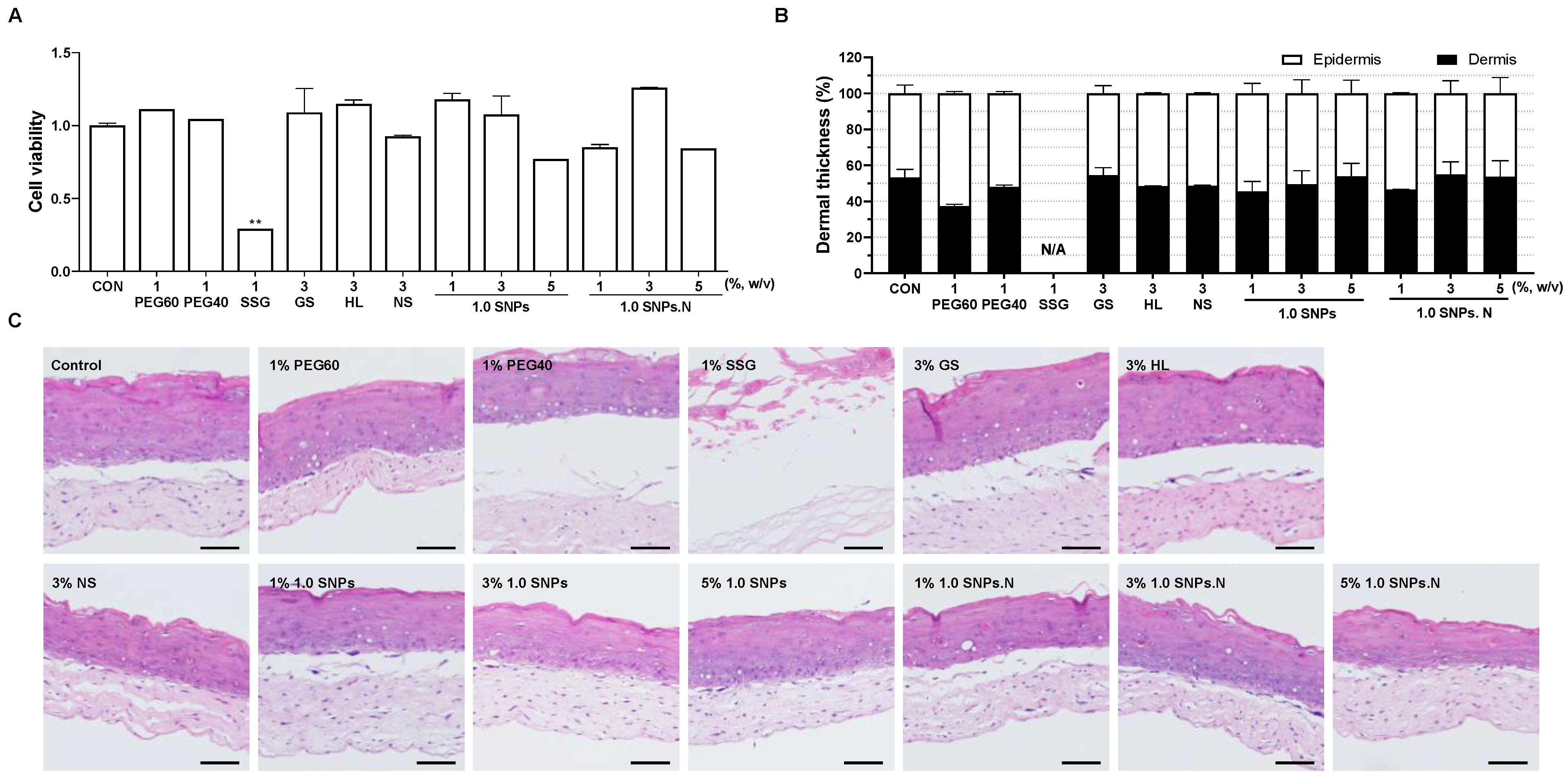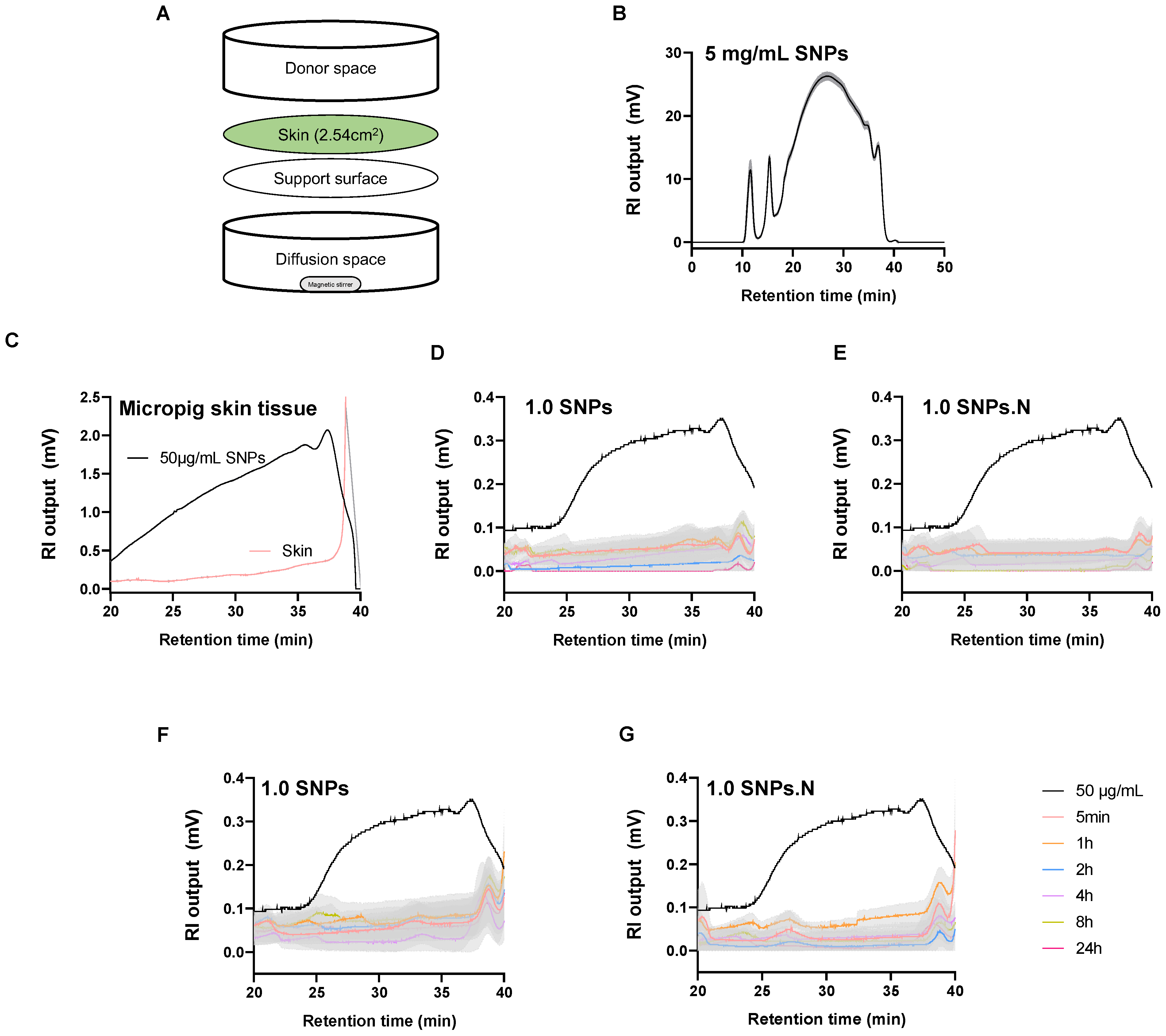Safety Assessment of Starch Nanoparticles as an Emulsifier in Human Skin Cells, 3D Cultured Artificial Skin, and Human Skin
Abstract
1. Introduction
2. Results
2.1. Cytotoxicity of SNPs in HaCaT Cells and HDF Cells
2.2. Emulsification of SNPs
2.3. The Effects of 1.0 SNPs and 1.0 SNPs.N in a 3D Cultured Skin Model
2.4. The Permeation Effects of 1.0 SNPs and 1.0 SNPs.N in a Diffusion System
2.5. The Irritation Effects of 1.0 SNPs and 1.0 SNPs.N on Human Skin
3. Discussion
4. Materials and Methods
4.1. Preparation of Starch Nanoparticles (SNPs) and Emulsification Test
4.2. Cell Culture and Cell Viability Analysis
4.3. Cell Viability Analysis in a Reconstituted 3D Human Skin Model
4.4. Histological Observation
4.5. Skin Permeation Test
4.6. High-Performance Size Exclusion Chromatography
4.7. Skin Irritation Assessment
4.8. Statistical Analysis
Author Contributions
Funding
Institutional Review Board Statement
Informed Consent Statement
Acknowledgments
Conflicts of Interest
Sample Availability
Abbreviations
References
- Abismal, B.; Canselier, J.; Wilhelm, A.; Delmas, H.; Gourdon, C. Emulsification by ultrasound: Drop size distribution and stability. Ultrason. Sonochem. 1999, 6, 75–83. [Google Scholar] [CrossRef] [PubMed]
- Kale, S.N.; Deore, S.L. Emulsion Micro Emulsion and Nano Emulsion: A Review. Syst. Rev. Pharm. 2017, 8, 39–47. [Google Scholar] [CrossRef]
- Vieira, M.V.; Pastrana, L.M.; Fucinos, P. Microalgae Encapsulation Systems for Food, Pharmaceutical and Cosmetics Applica-tions. Mar. Drugs 2020, 18, 644. [Google Scholar] [CrossRef] [PubMed]
- Tamang, N.; Shrestha, P.; Khadka, B.; Mondal, M.H.; Saha, B.; Bhattarai, A. A Review of Biopolymers’ Utility as Emulsion Stabilizers. Polymers 2021, 14, 127. [Google Scholar] [CrossRef]
- Corazza, M.; Virgili, A.; Ricci, M.; Bianchi, A.; Borghi, A. Contact Sensitization to Emulsifying Agents: An Underrated Issue? Dermatitis 2016, 27, 276–281. [Google Scholar] [CrossRef]
- Moore, D.J.; Caso, S.; Vincent, C.; Ananthapadmanabhan, K. pH induced alterations in stratum corneum properties. J. Am. Acad. Dermatol. 2004, 25, 33. [Google Scholar] [CrossRef]
- Bornkessel, A.; Flach, M.; Elsner, P.; Fluhr, J.W.; Arens-Corell, M. Functional assessment of a washing emulsion for sensitive skin: Mild impairment of stratum corneum hydration, pH, barrier function, lipid content, integrity and cohesion in a controlled washing test. Ski. Res. Technol. 2005, 11, 53–60. [Google Scholar] [CrossRef]
- Zhu, F. Starch based Pickering emulsions: Fabrication, properties, and applications. Trends Food Sci. Technol. 2019, 85, 129–137. [Google Scholar] [CrossRef]
- Li, C.; Li, Y.; Sun, P.; Yang, C. Starch nanocrystals as particle stabilisers of oil-in-water emulsions. J. Sci. Food Agric. 2014, 94, 1802–1807. [Google Scholar] [CrossRef]
- Ko, E.B.; Kim, J.-Y. Application of starch nanoparticles as a stabilizer for Pickering emulsions: Effect of environmental factors and approach for enhancing its storage stability. Food Hydrocoll. 2021, 120, 106984. [Google Scholar] [CrossRef]
- Fresco-Cala, B.; Cárdenas, S. Advanced polymeric solids containing nano- and micro-particles prepared via emulsion-based polymerization approaches. A review. Anal. Chim. Acta 2022, 1208, 339669. [Google Scholar] [CrossRef] [PubMed]
- Angellier, H.; Choisnard, L.; Molina-Boisseau, S.; Ozil, P.; Dufresne, A. Optimization of the preparation of aqueous suspensions of waxy maize starch nanocrystals using a response sur-face methodology. Biomacromolecules 2004, 5, 1545–1551. [Google Scholar] [CrossRef] [PubMed]
- Choi, H.-D.; Hong, J.S.; Pyo, S.M.; Ko, E.; Shin, H.-Y.; Kim, J.-Y. Starch nanoparticles produced via acidic dry heat treatment as a stabilizer for a Pickering emulsion: Influence of the physical properties of particles. Carbohydr. Polym. 2020, 239, 116241. [Google Scholar] [CrossRef] [PubMed]
- Pirozzi, A.; Capuano, R.; Avolio, R.; Gentile, G.; Ferrari, G.; Donsì, F. O/W Pickering Emulsions Stabilized with Cellulose Nanofibrils Produced through Different Mechanical Treatments. Foods 2021, 10, 1886. [Google Scholar] [CrossRef] [PubMed]
- Chen, L.; Ao, F.; Ge, X.; Shen, W. Food-Grade Pickering Emulsions: Preparation, Stabilization and Applications. Molecules 2020, 25, 3202. [Google Scholar] [CrossRef]
- Pralong, P.; Dendooven, E.; Aerts, O. Sodium stearoyl glutamate: Another amino acid alkyl amide sensitizer in cosmetics. Contact Dermat. 2022, 87, 453–454. [Google Scholar] [CrossRef]
- Rahma, A.; Lane, M.E. Skin Barrier Function in Infants: Update and Outlook. Pharmaceutics 2022, 14, 433. [Google Scholar] [CrossRef]
- Bárány, E.; Lindberg, M.; Lodén, M. Unexpected skin barrier influence from nonionic emulsifiers. Int. J. Pharm. 2000, 195, 189–195. [Google Scholar] [CrossRef]
- Navarro-Triviño, F.J.; Ruiz-Villaverde, R. Allergic contact dermatitis in a psoriasis patient caused by cetylstearyl alcohol. Contact. Dermat. 2022, 87, 283–285. [Google Scholar] [CrossRef]
- Nishioka, K.; Koizumi, A.; Takita, Y. Seven cases of contact dermatitis due to stearyl alcohol contained in topical medications. J. Dermatol. 2022, 49, 515–518. [Google Scholar] [CrossRef]
- McClements, D.J.; Gumus, C.E. Natural emulsifiers—Biosurfactants, phospholipids, biopolymers, and colloidal particles: Molecu-lar and physicochemical basis of functional performance. Adv. Colloid Interf. Sci. 2016, 234, 3–26. [Google Scholar] [CrossRef]
- Williams, R.M. Makeup goes organic. Townsend Lett. Exam. Altern. Med. 2006, 273, 44–47. [Google Scholar]
- Uter, W.; Werfel, T.; White, I.R.; Johansen, J.D. Contact Allergy: A Review of Current Problems from a Clinical Perspective. Int. J. Environ. Res. Public Health 2018, 15, 1108. [Google Scholar] [CrossRef]
- Hannuksela, M.; Kousa, M.; Pirilä, V. Contact sensitivity to emulsifiers. Contact. Dermat. 1976, 2, 201–204. [Google Scholar] [CrossRef]
- Hannuksela, M. Skin contact allergy to emulsifiers. Int. J. Cosmet. Sci. 1988, 10, 9–14. [Google Scholar] [CrossRef]
- He, B.; Wang, Y.; Peng, D.; Wang, L.; Dong, Z. Screening of HaCaT Clones for CCL20 Gene Knockout and Preliminary Exploration of Gene-Targeting Vector Transfection Approaches in this Cell Line. Med. Sci. Monit. Basic Res. 2015, 21, 21–28. [Google Scholar] [CrossRef]
- Bautista-Hernández, L.A.; Gómez-Olivares, J.L.; Buentello-Volante, B.; Bautista-De Lucio, V.M. Fibroblasts: The unknown sentinels eliciting immune responses against microorganisms. Eur. J. Microbiol. Immunol. 2017, 7, 151–157. [Google Scholar] [CrossRef]
- Fiume, M.M.; Bergfeld, W.F.; Belsito, D.V.; Hill, R.A.; Klaassen, C.D.; Liebler, D.C.; Marks, J.J.G.; Shank, R.C.; Slaga, T.J.; Snyder, P.W.; et al. Safety Assessment of PEGylated Alkyl Glycerides as Used in Cosmetics. Int. J. Toxicol. 2020, 39, 26S–58S. [Google Scholar] [CrossRef] [PubMed]
- Benavides, T.; Mitjans, M.; Martínez, V.; Clapés, P.; Infante, M.R.; Clothier, R.H.; Vinardell, M.P. Assessment of primary eye and skin irritants by in vitro cytotoxicity and phototoxicity models: An in vitro ap-proach of new arginine-based surfactant-induced irritation. Toxicology 2004, 197, 229–237. [Google Scholar] [CrossRef] [PubMed]
- Weyenberg, W.; Filev, P.; Van den Plas, D.; Vandervoort, J.; De Smet, K.; Sollie, P.; Ludwig, A. Cytotoxicity of submicron emulsions and solid lipid nanoparticles for dermal application. Int. J. Pharm. 2007, 337, 291–298. [Google Scholar] [CrossRef] [PubMed]
- Wilhelm, K.P.; Böttjer, B.; Siegers, C.P. Quantitative assessment of primary skin irritants in vitro in a cytotoxicity model: Comparison with in vivo human irritation tests. Br. J. Dermatol. 2001, 145, 709–715. [Google Scholar] [CrossRef]
- Korting, H.; Herzinger, T.; Hartinger, A.; Kerscher, M.; Angerpointner, T.; Maibach, H. Discrimination of the irritancy potential of surfactants in vitro by two cytotoxicity assays using normal human keratinocytes, HaCaT cells and 3T3 mouse fibroblasts: Correlation with in vivo data from a soap chamber assay. J. Dermatol. Sci. 1994, 7, 119–129. [Google Scholar] [CrossRef] [PubMed]
- Teimouri, A.; Yeung, P.; Agu, R. 2D vs. 3D Cell Culture Models for In Vitro Topical (Dermatological) Medication Testing. In Cell Culture; Intech Open: London, UK, 2018. [Google Scholar] [CrossRef]
- Effendy, I.; Maibach, H.I. Surfactants and experimental irritant contact dermatitis. Contact Dermat. 1995, 33, 217–225. [Google Scholar] [CrossRef]
- Morris, S.A.; Ananthapadmanabhan, K.P.; Kasting, G.B. Anionic Surfactant–Induced Changes in Skin Permeability. J. Pharm. Sci. 2019, 108, 3640–3648. [Google Scholar] [CrossRef] [PubMed]
- Wilhelm, K.P.; Cua, A.B.; Wolff, H.H.; Maibach, H.I. Surfactant-induced stratum corneum hydration in vivo: Prediction of the irritation potential of anionic surfac-tants. J. Investig. Derm. 1993, 101, 310–315. [Google Scholar] [CrossRef] [PubMed]
- Barua, N.; Huang, L.; Li, C.; Yang, Y.; Luo, M.; Wei, W.I.; Wong, K.T.; Lo, N.W.S.; Kwok, K.O.; Ip, M. Comparative Study of Two-Dimensional (2D) vs. Three-Dimensional (3D) Organotypic Kertatinocyte-Fibroblast Skin Models for Staphylococcus aureus (MRSA) Infection. Int. J. Mol. Sci. 2022, 23, 299. [Google Scholar] [CrossRef]
- Sun, T.; Jackson, S.; Haycock, J.; MacNeil, S. Culture of skin cells in 3D rather than 2D improves their ability to survive exposure to cytotoxic agents. J. Biotechnol. 2006, 122, 372–381. [Google Scholar] [CrossRef]
- Breslin, S.; O’Driscoll, L. The relevance of using 3D cell cultures, in addition to 2D monolayer cultures, when evaluating breast cancer drug sensitivity and resistance. Oncotarget 2016, 7, 45745–45756. [Google Scholar] [CrossRef]
- Gloor, M. How do dermatological vehicles influence the horny layer? Ski. Pharm. Physiol 2004, 17, 267–273. [Google Scholar] [CrossRef]
- Zesch, A. Adverse reactions of externally applied drugs and inert substances. Dermatosen Beruf und Umwelt. Occup. Environ. 1988, 36, 128–133. [Google Scholar]
- Chen, Y.; Qiao, F.; Fan, Y.; Han, Y.; Wang, Y. Interactions of Cationic/Anionic Mixed Surfactant Aggregates with Phospholipid Vesicles and Their Skin Penetration Ability. Langmuir 2017, 33, 2760–2769. [Google Scholar] [CrossRef]
- Salvioni, L.; Morelli, L.; Ochoa, E.; Labra, M.; Fiandra, L.; Palugan, L.; Prosperi, D.; Colombo, M. The emerging role of nanotechnology in skincare. Adv. Colloid Interf. Sci. 2021, 293, 102437. [Google Scholar] [CrossRef]
- James-Smith, M.A.; Hellner, B.; Annunziato, N.; Mitragotri, S. Effect of Surfactant Mixtures on Skin Structure and Barrier Properties. Ann. Biomed. Eng. 2010, 39, 1215–1223. [Google Scholar] [CrossRef]
- Abd, E.; Yousuf, S.A.; Pastore, M.N.; Telaprolu, K.; Mohammed, Y.; Namjoshi, S.; Grice, J.E.; Roberts, M.S. Skin models for the testing of transdermal drugs. Clin. Pharmacol. Adv. Appl. 2016, 8, 163–176. [Google Scholar] [CrossRef]
- Miskeen, S.; An, Y.S.; Kim, J.-Y. Application of starch nanoparticles as host materials for encapsulation of curcumin: Effect of citric acid modification. Int. J. Biol. Macromol. 2021, 183, 1–11. [Google Scholar] [CrossRef] [PubMed]
- Yang, Y.-I.; Woo, J.-H.; Seo, Y.-J.; Lee, K.-T.; Lim, Y.; Choi, J.-H. Protective Effect of Brown Alga Phlorotannins against Hyper-inflammatory Responses in Lipopolysaccharide-Induced Sepsis Models. J. Agric. Food Chem. 2016, 64, 570–578. [Google Scholar] [CrossRef] [PubMed]
- Huh, M.-I.; Kim, M.-S.; Kim, H.-K.; Lim, J.O. Effect of conditioned media collected from human amniotic fluid-derived stem cells (hAFSCs) on skin regeneration and photo-aging. Tissue Eng. Regen. Med. 2014, 11, 171–177. [Google Scholar] [CrossRef]
- Kang, Y.-M.; Seo, M.-G.; Lee, K.-Y.; An, H.-J. Potential of Extracts of Yin-Tonic Herbal Medicine in Skin Cell and Human Skin Equivalent. Evid. Based Complement. Altern. Med. 2020, 2020, 8881207. [Google Scholar] [CrossRef] [PubMed]
- Kim, K.; Kim, J.; Kim, H.; Sung, G. Effect of α-Lipoic Acid on the Development of Human Skin Equivalents Using a Pumpless Skin-on-a-Chip Model. Int. J. Mol. Sci. 2021, 22, 2160. [Google Scholar] [CrossRef] [PubMed]
- Guth, K.; Schäfer-Korting, M.; Fabian, E.; Landsiedel, R.; van Ravenzwaay, B. Suitability of skin integrity tests for dermal absorption studies in vitro. Toxicol. Vitr. 2015, 29, 113–123. [Google Scholar] [CrossRef] [PubMed]
- Yao, Y.; Guiltinan, M.J.; Thompson, D.B. High-performance size-exclusion chromatography (HPSEC) and fluorophore-assisted carbohydrate electrophoresis (FACE) to describe the chain-length distribution of debranched starch. Carbohydr. Res. 2005, 340, 701–710. [Google Scholar] [CrossRef] [PubMed]
- Wade, J.H.; Bailey, R.C. Refractive index-based detection of gradient elution liquid chromatography using chip-integrated mi-croring resonator arrays. Anal. Chem. 2014, 86, 913–919. [Google Scholar] [CrossRef] [PubMed]
- Yoo, M.A.; Kim, S.H.; Han, H.S.; Byun, J.W.; Park, K.H. The effects of wearing a face mask and of subsequent moisturizer use on the characteristics of sensitive skin. Ski. Res. Technol. 2022, 28, 714–718. [Google Scholar] [CrossRef] [PubMed]




| Sample Name | Concentration | Visual Assessment Grade | Skin Irritation Index | Irritation Evaluation | |
|---|---|---|---|---|---|
| After 30 min | After 24 h | ||||
| 1.0 SNPs | 1% (w/v) | 0 | 0 | 0.00 | No irritation |
| 1.0 SNPs.N | 0 | 0 | 0.00 | No irritation | |
| Sample Name | Vehicle | Acid Addition | Heating Time | Neutralization |
|---|---|---|---|---|
| Normal starch | 0.0 mL | 0 h | X | |
| 0.6 SNPs | Distilled water | 0.6 mL | 2 h | X |
| 0.8 SNPs | Distilled water | 0.8 mL | 2 h | X |
| 1.0 SNPs | Distilled water | 1.0 mL | 2 h | X |
| 1.0 SNPs.N | Distilled water | 1.0 mL | 2 h | O |
| 1.2 SNPs | Distilled water | 1.2 mL | 2 h | X |
| 1.2 SNPs.N | 30% EtOH | 1.2 mL | 3 h | O |
| Sample Name | Trade Name | Type |
|---|---|---|
| PEG60 hydrogenated castor oil | PEG60 | Non-ionic synthetic emulsifier |
| PEG40 stearate | PEG40 | Non-ionic synthetic emulsifier |
| Sodium stearoyl glutamate | SSG | Anionic synthetic emulsifier |
| Glyceryl stearate | GS | Naturally derived emulsifier |
| Hydrogenated lecithin | HL | Naturally derived emulsifier |
| Symbol | Grade | Symptoms |
|---|---|---|
| 0 | No reaction | |
| + | 1 | Slight erythema, either spotty of diffuse |
| ++ | 2 | Moderate uniform erythema |
| +++ | 3 | Intense erythema with edema |
| ++++ | 4 | Intense erythema with edema and vesicles |
| Skin Irritation Index | Irritation Evaluation |
|---|---|
| 0.00~0.25 | No irritation |
| 0.26~1.00 | Mild irritation |
| 1.01~2.50 | Medium irritation |
| 2.51~4.00 | Strong irritation |
Disclaimer/Publisher’s Note: The statements, opinions and data contained in all publications are solely those of the individual author(s) and contributor(s) and not of MDPI and/or the editor(s). MDPI and/or the editor(s) disclaim responsibility for any injury to people or property resulting from any ideas, methods, instructions or products referred to in the content. |
© 2023 by the authors. Licensee MDPI, Basel, Switzerland. This article is an open access article distributed under the terms and conditions of the Creative Commons Attribution (CC BY) license (https://creativecommons.org/licenses/by/4.0/).
Share and Cite
Kim, S.-Y.; Shin, H.-Y.; Kim, J.-Y.; Park, S.J. Safety Assessment of Starch Nanoparticles as an Emulsifier in Human Skin Cells, 3D Cultured Artificial Skin, and Human Skin. Molecules 2023, 28, 806. https://doi.org/10.3390/molecules28020806
Kim S-Y, Shin H-Y, Kim J-Y, Park SJ. Safety Assessment of Starch Nanoparticles as an Emulsifier in Human Skin Cells, 3D Cultured Artificial Skin, and Human Skin. Molecules. 2023; 28(2):806. https://doi.org/10.3390/molecules28020806
Chicago/Turabian StyleKim, So-Yeon, Hye-Young Shin, Jong-Yea Kim, and Se Jin Park. 2023. "Safety Assessment of Starch Nanoparticles as an Emulsifier in Human Skin Cells, 3D Cultured Artificial Skin, and Human Skin" Molecules 28, no. 2: 806. https://doi.org/10.3390/molecules28020806
APA StyleKim, S.-Y., Shin, H.-Y., Kim, J.-Y., & Park, S. J. (2023). Safety Assessment of Starch Nanoparticles as an Emulsifier in Human Skin Cells, 3D Cultured Artificial Skin, and Human Skin. Molecules, 28(2), 806. https://doi.org/10.3390/molecules28020806







